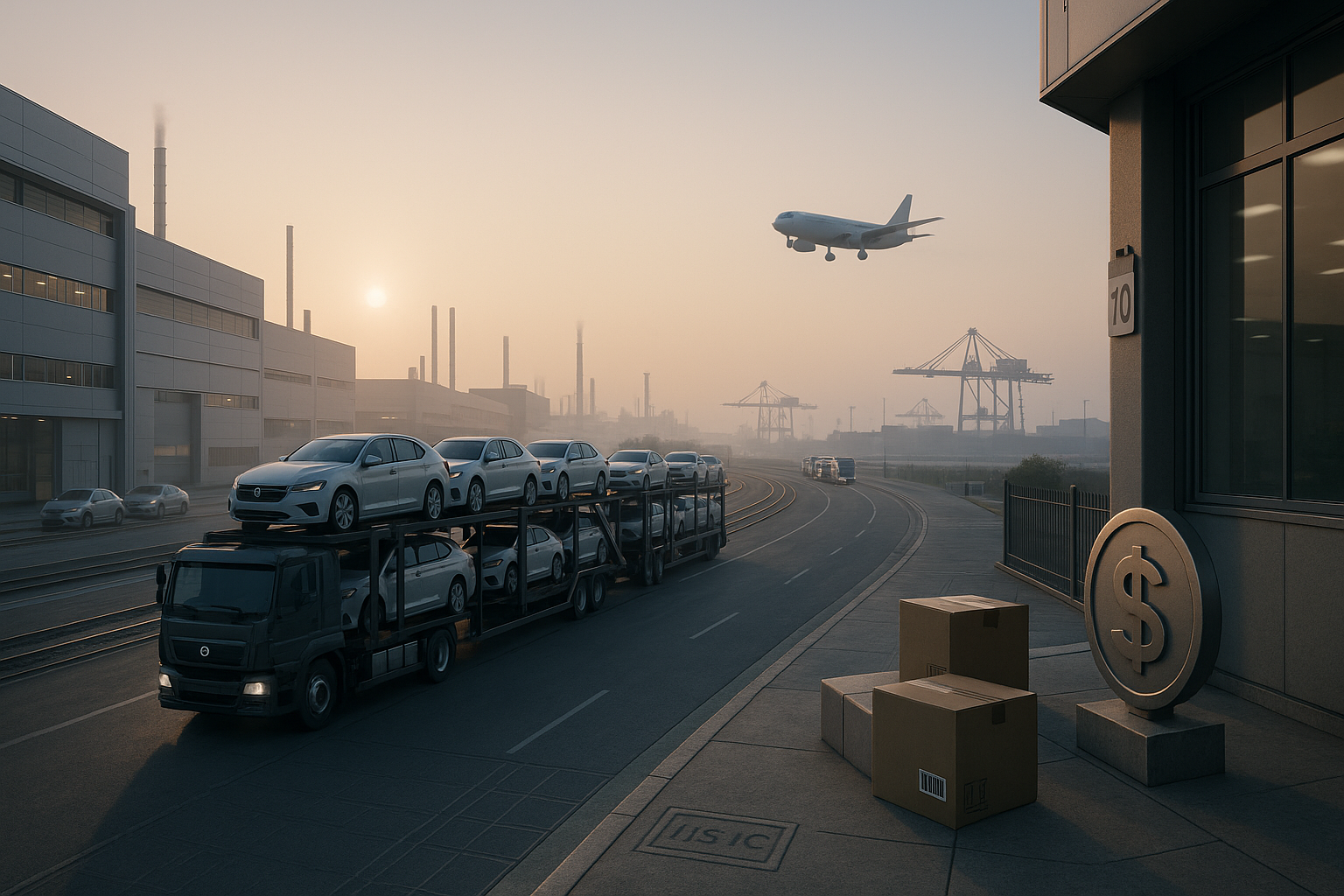Daily Cross-Border E-Commerce Briefing | October 16, 2025
1. US–China Port Fees Push VLCC Rates Higher, Signaling Q4 Cost & Transit Volatility
-
Escalating port-fee measures between the U.S. and China are spilling into global shipping. Very
Large Crude Carrier (VLCC) spot rates on the Middle East–China TD3C lane briefly hit W98 before
easing to W95—well above last week’s W70—after China introduced retaliatory port charges and U.S.
sanctions squeezed capacity. For one-piece dropshipping brands, higher bunker surcharges and
schedule reshuffles can cascade into parcel lanes via missed transshipment windows and vessel
bunching. Practical moves: lock priority lanes for BFCM/holiday SKUs, set a 2%–5% shipping buffer
into retail pricing, and publish a concise “Taxes & Fees” explainer on PDP/checkout to prevent
post-purchase disputes.
Source: Reuters, Published on: October 15, 2025
2. China’s Retaliatory Port Fees: 400 CNY/Net Ton for US-Linked Ships, Exemptions for China-Built Vessels
-
China’s counter-measures target vessels with meaningful U.S. nexus (build/operation/ownership
thresholds), setting port fees at 400 CNY per net tonne and prompting carriers to rethink port
rotations (e.g., shifting calls to hubs like Zhoushan). Analysts warn a wider freight-rate uplift
and knock-on congestion are likely if diversions persist. For DTC sellers relying on one-piece
direct injection, this raises the probability of longer door-to-door transit and ad-hoc surcharges.
Action items: keep a secondary routing option per destination market and communicate
delivery-promise tiers (Express vs. Economy) clearly in your storefront.
Source: Reuters Breakingviews, Published on: October 15, 2025
3. Shopify Raises Variant Limit to 2,048—Cleaner Catalogs for Complex Size/Color Trees
-
Shopify confirmed that all merchants can now create up to 2,048 variants per
product, a leap from the long-standing 100-variant cap. Stores with apparel,
accessories, and configurable bundles can consolidate “SKU explosions” into native variants,
reducing reliance on third-party variant apps that slow PDP load or break syncing. For one-piece
dropship workflows, a leaner catalog improves availability mapping, avoids overselling during peaks,
and cuts edge-case errors in order handoff.
Source: Shopify Developer Changelog, Published on: October 15, 2025
4. Stripe’s Bridge Applies for US National Trust Bank Charter—A Signal for Faster, Cheaper Cross-Border Settlement
-
Bridge, Stripe’s stablecoin infrastructure unit, has applied to the U.S. OCC for a national trust
bank charter. If approved, it could offer supervised digital-asset custody, stablecoin issuance, and
reserve management. For independent stores dealing with high AOV or B2B wholesale orders, this could
enable faster settlement with lower fees and fewer chargeback risks compared to legacy rails.
Consider piloting “dual-track” checkout (fiat + stablecoin) with clear refund/FX rules for
international buyers.
Source: BankingDive, Published on: October 15, 2025
5. Malwarebytes: New TikTok “Fake Balance” Scam Targets Creators & Shoppers
-
Security researchers flagged a TikTok scam that lures users via DMs with claims of “unlockable”
in-app balances. The scheme pushes victims to off-platform paywalls or credential phishing. For
brands running UGC collaborations or Spark Ads, tighten creator vetting, require parameterized
affiliate links, and mandate on-platform disclosures to avoid account strikes. Add a safety note in
your influencer briefs and ensure your social team can rapidly revoke UTMs tied to compromised
creators.
Source: Malwarebytes, Published on: October 15, 2025
6. Freightos: Oct 16 Webinar Dissects Trade-War Port Fees, Ocean/Air Capacity into Peak Season
-
Freightos’ market update (Oct 16, 10:00 a.m. ET) focuses on how new U.S.–China port fees, signs of
container overcapacity, and shifting air capacity will shape Q4. Sellers can use the data to
calibrate route selection (e.g., balancing Express vs. Economy lanes), adjust promo calendars, and
time final cut-offs for holiday delivery promises.
Source: Freightos, Published on: October 16, 2025
7. Amazon Posts 2026 US Fee Update—Signals Still-Muted Cost Inflation vs. 2025
-
Amazon’s Selling Partner notice outlines 2026 U.S. fee changes (e.g., FBA up by an average of $0.08
per unit, <0.5% of a typical item price) and reiterates no increase in U.S. Referral and FBA fees
during 2025. For DTC brands using Amazon alongside their own sites, model small COGS/fulfillment
uplifts for multi-channel pricing and margin planning into early 2026, while keeping your store’s
delivery value proposition clear to defend DTC AOV.
Source: Amazon Selling Partner Updates, Published on: October 15, 2025
8. Chicago Fed: US Retail Sales ex-Autos Likely Rose Again—Holiday Demand Looks Discount-Driven
-
The Chicago Fed’s CARTS model estimates a seasonally-adjusted September increase in retail sales
excluding autos. Inflation tempers real gains, suggesting shoppers will remain price-sensitive into
BFCM. Action for one-piece dropship sellers: pair threshold-based discounts (e.g., “$59+ free
shipping”) with bundles, segment bids by region, and reflect delivery-speed tiers in ad creatives to
match discount-seeking behavior.
Source: Reuters, Published on: October 16, 2025
9. TAC Index: Global Air Freight Rates Dipped 1.2% (w/e Oct 13), Mixed by Region Post-Golden Week
-
Latest TAC Index data show a 1.2% week-on-week decline in global air cargo rates, with Asia origin
softening while Hong Kong, Europe, and North America ticked up after the holiday. For SMB DTC
brands, this favors time-sensitive replenishment from select hubs; combine volumetric-weight
optimization (lighter packaging, smaller mailers) with route selection to protect gross margin on
Express lanes.
Source: STAT Times (citing TAC Index), Published on: October 15, 2025
10. UPS Market Update: US Truckload Spot Rates Stabilize—Mind Regional Imbalances
-
UPS’ October 15 U.S. market note highlights a modest rebound in dry-van spot rates (average
$1.70/mi; Midwest ~$1.92) alongside imbalances across regions. While parcel contracts differ from TL
spot, regional trucking tightness often bleeds into last-mile costs, especially for oversized
parcels. Tip: surface “delivery estimates by state” on PDP for bulky items and set safeguard buffers
in ad-set targeting where delivery promises are tightest.
Source: UPS, Published on: October 15, 2025






